Silicon Carbide Nanostructures as Potential Carbide Material for Electrochemical Supercapacitors: A Review
Abstract
1. Introduction
2. Crystallographic Structure of SiC
3. Synthesis Process of SiC Nanoarchitectures
3.1. 0D SiC Nanoarchitectures
3.2. 1D SiC Nanoarchitectures
3.3. 2D SiC Nanoarchitectures
3.4. 3D SiC Nanoarchitectures
4. Properties of SiC Nanoarchitectures
4.1. Mechanical Properties
4.2. Thermal Properties
4.3. Electrical Properties
4.4. Dielectric Property
4.5. Wetting Property
5. Supercapacitor Applications
6. Conclusions and Outlooks
Author Contributions
Funding
Data Availability Statement
Conflicts of Interest
References
- Zheng:, Y.; Chen, K.; Jiang, K.; Zhang, F.; Zhu, G.; Xu, H. Progress of synthetic strategies and properties of heteroatoms-doped (N, P, S, O) carbon materials for supercapacitors. J. Energy Storage 2022, 56, 105995. [Google Scholar] [CrossRef]
- Acharya, D.; Pathak, I.; Dahal, B.; Lohani, P.; Bhattarai, R.; Muthurasu, A.; Kim, T.; Ko, T.; Chhetri, K.; Ki, H.M. Immoderate nanoarchitectures of bimetallic MOF derived Ni–Fe–O/NPC on porous carbon nanofibers as freestanding electrode for asymmetric supercapacitors. Carbon 2023, 201, 12–23. [Google Scholar] [CrossRef]
- Ojha, G.; Pant, B.; Acharya, J.; Park, M. Prussian Red Anions Immobilized Freestanding Three-Dimensional Porous Carbonaceous Networks: A New Avenue to Attain Capacitor- and Faradic-Type Electrodes in a Single Frame for 2.0 V Hybrid Supercapacitors. ACS Sustain. Chem. Eng. 2022, 10, 2994–3006. [Google Scholar] [CrossRef]
- Pant, B.; Ojha, G.; Acharya, J.; Pant, H.; Park, M. Lokta paper-derived free-standing carbon as a binder-free electrode material for high-performance supercapacitors. Sustain. Mater. Technol. 2022, 33, e00450. [Google Scholar] [CrossRef]
- Acharya, J.; Raj, B.; Ko, T.; Khil, M.-S.; Kim, H.-Y.; Kim, B.-S. Facile one pot sonochemical synthesis of CoFe2O4/MWCNTs hybrids with well-dispersed MWCNTs for asymmetric hybrid supercapacitor applications. Int. J. Hydrogen Energy 2020, 45, 3073–3085. [Google Scholar] [CrossRef]
- Poudel, M.; Kim, H. Synthesis of high-performance nickel hydroxide nanosheets/gadolinium doped-α-MnO2 composite nanorods as cathode and Fe3O4/GO nanospheres as anode for an all-solid-state asymmetric supercapacitor. J. Energy Chem. 2022, 64, 475–484. [Google Scholar] [CrossRef]
- Chen, T.; Dai, L. Carbon nanomaterials for high-performance supercapacitors. Mater. Today 2013, 16, 272–280. [Google Scholar] [CrossRef]
- Zheng, S.; Zhang, J.; Deng, H.; Du, Y.; Shi, X. Chitin derived nitrogen-doped porous carbons with ultrahigh specific surface area and tailored hierarchical porosity for high performance supercapacitors. J. Bioresour. Bioprod. 2021, 6, 142–151. [Google Scholar] [CrossRef]
- Muthurasu, A.; Ojha, G.; Lee, M.; Kim, H. Zeolitic imidazolate framework derived Co3S4 hybridized MoS2–Ni3S2 heterointerface for electrochemical overall water splitting reactions. Electrochim. Acta 2020, 334, 135537. [Google Scholar] [CrossRef]
- Muthurasu, A.; Ojha, G.; Lee, M.; Kim, H. Integration of Cobalt Metal–Organic Frameworks into an Interpenetrated Prussian Blue Analogue to Derive Dual Metal–Organic Framework-Assisted Cobalt Iron Derivatives for Enhancing Electrochemical Total Water Splitting. J. Phys. Chem. C 2020, 124, 14465–14476. [Google Scholar] [CrossRef]
- Pandey, P.; Thapa, K.; Ojha, G.; Seo, M.-K.; Shin, K.; Kim, S.-W.; Sohn, J. Metal-organic frameworks-based triboelectric nanogenerator powered visible light communication system for wireless human-machine interactions. Chem. Eng. J. 2023, 452, 139209. [Google Scholar] [CrossRef]
- Ojha, G.; Gautam, J.; Muthurasu, A.; Lee, M.; Dahal, B.; Mukhiya, T.; Lee, J.; Tiwari, A.; Chhetri, K.; Kim, H. In-situ fabrication of manganese oxide nanorods decorated manganese oxide nanosheets as an efficient and durable catalyst for oxygen reduction reaction. Colloids Surf. A Physicochem. Eng. Asp. 2019, 568, 311–318. [Google Scholar] [CrossRef]
- Lohani, P.; Tiwari, A.; Chhetri, K.; Muthurasu, A.; Dahal, B.; Chae, S.-H.; Ko, T.; Lee, J.; Chung, Y.; Kim, H. Polypyrrole Nanotunnels with Luminal and Abluminal Layered Double Hydroxide Nanosheets Grown on a Carbon Cloth for Energy Storage Applications. ACS Appl. Mater. Interfaces 2022, 14, 23285–23296. [Google Scholar] [CrossRef]
- Acharya, J.; Ojha, G.; Kim, B.-S.; Pant, B.; Park, M. Modish Designation of Hollow-Tubular rGO–NiMoO4@Ni–Co–S Hybrid Core–shell Electrodes with Multichannel Superconductive Pathways for High-Performance Asymmetric Supercapacitors. ACS Appl. Mater. Interfaces 2021, 13, 17487–17500. [Google Scholar] [CrossRef]
- Balamurugan, J.; Li, C.; Aravindan, V.; Kim, N.; Lee, J. Hierarchical Ni-Mo-S and Ni-Fe-S Nanosheets with Ultrahigh Energy Density for Flexible All Solid-State Supercapacitors. Adv. Funct. Mater. 2018, 28, 1803287. [Google Scholar] [CrossRef]
- Zhang, X.; Chen, A.; Zhong, M.; Zhang, Z.; Zhang, X.; Zhou, Z.; Bu, X.-H. Metal–Organic Frameworks (MOFs) and MOF-Derived Materials for Energy Storage and Conversion. Electrochem. Energy Rev. 2019, 2, 29–104. [Google Scholar] [CrossRef]
- Wei, L.; Deng, W.; Li, S.; Wu, Z.; Cai, J.; Luo, J. Sandwich-like chitosan porous carbon Spheres/MXene composite with high specific capacitance and rate performance for supercapacitors. J. Bioresour. Bioprod. 2022, 7, 63–72. [Google Scholar] [CrossRef]
- Ojha, G.; Muthurasu, A.; Dahal, B.; Mukhiya, T.; Kang, D.; Kim, H.-Y. Oleylamine-assisted synthesis of manganese oxide nanostructures for high-performance asymmetric supercapacitos. J. Electroanal. Chem. 2019, 837, 254–265. [Google Scholar] [CrossRef]
- Kim, T.; Song, W.; Son, D.-Y.; Ono, L.; Qi, Y. Lithium-ion batteries: Outlook on present, future, and hybridized technologies. J. Mater. Chem. A 2019, 7, 2942–2964. [Google Scholar] [CrossRef]
- Acharya, J.; Ko, T.; Seo, M.-K.; Khil, M.-S.; Kim, H.-Y.; Kim, B.-S. Oxalic acid assisted rapid synthesis of mesoporous NiCo2O4 nanorods as electrode materials with higher energy density and cycle stability for high-performance asymmetric hybrid supercapacitor applications. J. Colloid Interface Sci. 2020, 564, 65–76. [Google Scholar] [CrossRef]
- Ojha, G.; Pant, B.; Park, S.-J.; Park, M.; Kim, H.-Y. Synthesis and characterization of reduced graphene oxide decorated with CeO2-doped MnO2 nanorods for supercapacitor applications. J. Colloid Interface Sci. 2017, 494, 338–344. [Google Scholar] [CrossRef] [PubMed]
- Acharya, J.; Pant, B.; Ojha, G.; Park, M. Unlocking the potential of a novel hierarchical hybrid (Ni–Co)Se2@NiMoO4@rGO–NF core–shell electrode for high-performance hybrid supercapacitors. J. Mater. Chem. A 2022, 10, 7999–8014. [Google Scholar] [CrossRef]
- Ojha, G.P.; Muthurasu, A.; Tiwari, A.P.; Pant, B.; Chhetri, K.; Mukhiya, T.; Dahal, B.; Lee, M.; Park, M.; Kim, H.-Y. Vapor solid phase grown hierarchical CuxO NWs integrated MOFs-derived CoS2 electrode for high-performance asymmetric supercapacitors and the oxygen evolution reaction. Chem. Eng. J. 2020, 399, 125532. [Google Scholar] [CrossRef]
- Pant, B.; Park, M.; Ojha, G.; Park, J.; Kuk, Y.-S.; Lee, E.-J.; Kim, H.-Y.; Park, S.-J. Carbon nanofibers wrapped with zinc oxide nano-flakes as promising electrode material for supercapacitors. J. Colloid Interface Sci. 2018, 522, 40–47. [Google Scholar] [CrossRef]
- Zang, X.; Zhang, R.; Zhen, Z.; Lai, W.; Yang, C.; Kang, F.; Zhu, H. Flexible, temperature-tolerant supercapacitor based on hybrid carbon film electrodes. Nano Energy 2017, 40, 224–232. [Google Scholar] [CrossRef]
- Yan, B.; Feng, L.; Zheng, J.; Zhang, Q.; Jiang, S.; Zhang, C.; Ding, Y.; Han, J.; Chen, W.; He, S. High performance supercapacitors based on wood-derived thick carbon electrodes synthesized via green activation process. Inorg. Chem. Front. 2022, 9, 6108–6123. [Google Scholar] [CrossRef]
- Chhetri, K.; Dahal, B.; Tiwari, A.; Mukhiya, T.; Muthurasu, A.; Ojha, G.; Lee, M.; Kim, T.; Chae, S.-H.; Kim, H. Controlled Selenium Infiltration of Cobalt Phosphide Nanostructure Arrays from a Two-Dimensional Cobalt Metal–Organic Framework: A Self-Supported Electrode for Flexible Quasi-Solid-State Asymmetric Supercapacitors. ACS Appl. Energy Mater. 2021, 4, 404–415. [Google Scholar] [CrossRef]
- Pant, B.; Ojha, G.; Acharya, J.; Park, M. Eggshell membrane templated synthesis of Ni/MoC decorated carbon fibers with good electrochemical behavior. Int. J. Hydrogen Energy 2021, 46, 2774–2782. [Google Scholar] [CrossRef]
- Ojha, G.; Pant, B.; Muthurasu, A.; Chae, S.-H.; Park, S.-J.; Kim, T.; Kim, H.-Y. Three-dimensionally assembled manganese oxide ultrathin nanowires: Prospective electrode material for asymmetric supercapacitors. Energy 2019, 188, 116066. [Google Scholar] [CrossRef]
- Ojha, G.; Pant, B.; Acharya, J.; Park, M. An electrochemically reduced ultra-high mass loading three-dimensional carbon nanofiber network: A high energy density symmetric supercapacitor with a reproducible and stable cell voltage of 2.0 V. Nanoscale 2021, 13, 19537–19548. [Google Scholar] [CrossRef]
- You, Y.; Hua, X.; Cui, Y.; Wu, G.; Qiu, S.; Xia, Y.; Luo, Y.; Xu, F.; Sun, L.; Chu, H. Momordica Grosvenori Shell-Derived Porous Carbon Materials for High-Efficiency Symmetric Supercapacitors. Nanomaterials 2022, 12, 4204. [Google Scholar] [CrossRef] [PubMed]
- Acharya, J.; Ojha, G.; Pant, B.; Park, M. Construction of self-supported bimetallic MOF-mediated hollow and porous tri-metallic selenide nanosheet arrays as battery-type electrodes for high-performance asymmetric supercapacitors. J. Mater. Chem. A 2021, 9, 23977–23993. [Google Scholar] [CrossRef]
- Acharya, J.; Pant, B.; Ojha, G.P.; Park, M. Embellishing hierarchical 3D core-shell nanosheet arrays of ZnFe2O4@NiMoO4 onto rGO-Ni foam as a binder-free electrode for asymmetric supercapacitors with excellent electrochemical performance. J. Colloid Interface Sci. 2022, 610, 863–878. [Google Scholar] [CrossRef]
- Kang, D.; Ojha, G.; Kim, H. Preparation and characterization of nickel nanoparticles decorated carbon fibers derived from discarded ostrich eggshell membranes for supercapacitors application. Funct. Compos. Struct. 2019, 1, 045004. [Google Scholar] [CrossRef]
- Awasthi, G.; Bhattarai, D.; Maharjan, B.; Kim, K.-S.; Park, C.; Kim, C. Synthesis and characterizations of activated carbon from Wisteria sinensis seeds biomass for energy storage applications. J. Ind. Eng. Chem. 2019, 72, 265–272. [Google Scholar] [CrossRef]
- Appiah, E.; Dzikunu, P.; Mahadeen, N.; Ampong, D.; Mensah-Darkwa, K.; Kumar, A.; Gupta, R.; Adom-Asamoah, M. Biopolymers-Derived Materials for Supercapacitors: Recent Trends, Challenges, and Future Prospects. Molecules 2022, 27, 6556. [Google Scholar] [CrossRef] [PubMed]
- Li, X.; Li, W.; Liu, Q.; Chen, S.; Wang, L.; Gao, F.; Shao, G.; Tian, Y.; Lin, Z.; Yang, W. Robust High-Temperature Supercapacitors Based on SiC Nanowires. Adv. Funct. Mater. 2021, 31, 2008901. [Google Scholar] [CrossRef]
- Yan, B.; Zheng, J.; Wang, F.; Zhao, L.; Zhang, Q.; Xu, W.; He, S. Review on porous carbon materials engineered by ZnO templates: Design, synthesis and capacitance performance. Mater. Des. 2021, 201, 109518. [Google Scholar] [CrossRef]
- Srivastava, R.; Bhardwaj, S.; Kumar, A.; Singhal, R.; Scanley, J.; Broadbridge, C.; Gupta, R. Waste Citrus reticulata Assisted Preparation of Cobalt Oxide Nanoparticles for Supercapacitors. Nanomaterials 2022, 12, 4119. [Google Scholar] [CrossRef]
- Awasthi, G.; Poudel, M.; Shin, M.; Sharma, K.; Kim, H.; Yu, C. Facile synthesis of a copper oxide/molybdenum disulfide heterostructure for asymmetric supercapacitors of high specific energy. J. Energy Storage 2021, 42, 103140. [Google Scholar] [CrossRef]
- Pant, B.; Ojha, G.; Park, M. One-pot synthesis, characterization, and electrochemical studies of tin-nickel sulfide hybrid structures on nickel foam for supercapacitor applications. J. Energy Storage 2020, 32, 101954. [Google Scholar] [CrossRef]
- Wang, H.; Lin, J.; Shen, Z. Polyaniline (PANi) based electrode materials for energy storage and conversion. J. Sci. Adv. Mater. Devices 2016, 1, 225–255. [Google Scholar] [CrossRef]
- Poudel, M.; Ojha, G.; Kim, A.A.; Kim, H. Manganese-doped tungsten disulfide microcones as binder-free electrode for high performance asymmetric supercapacitor. J. Energy Storage 2022, 47, 103674. [Google Scholar] [CrossRef]
- Guo, X.-N.; Tong, X.-L.; Gu, X.-Y. Application of Silicon Carbide in Electrocatalysis. In Novel Carbon Materials and Composites: Synthesis, Properties and Applications; John Wiley & Sons: Hoboken, NJ, USA, 2019; pp. 73–97. [Google Scholar]
- Yang, N.; Zhuang, H.; Hoffmann, R.; Smirnov, W.; Hees, J.; Jiang, X.; Nebel, C. Electrochemistry of Nanocrystalline 3C Silicon Carbide Films. Chem.–A Eur. J. 2012, 18, 6514–6519. [Google Scholar] [CrossRef] [PubMed]
- Okoroanyanwu, U.; Bhardwaj, A.; Einck, V.; Ribbe, A.; Hu, W.; Rodriguez, J.; Schmidt, W.; Watkins, J. Rapid Preparation and Electrochemical Energy Storage Applications of Silicon Carbide and Silicon Oxycarbide Ceramic/Carbon Nanocomposites Derived Via Flash Photothermal Pyrolysis of Organosilicon Preceramic Polymers. Chem. Mater. 2021, 33, 678–694. [Google Scholar] [CrossRef]
- Xu, M.; Girish, Y.; Rakesh, K.; Wu, P.; Manukumar, H.; Byrappa, S.; Udayabhanu; Byrappa, K. Recent advances and challenges in silicon carbide (SiC) ceramic nanoarchitectures and their applications. Mater. Today Commun. 2021, 28, 102533. [Google Scholar] [CrossRef]
- Aspenberg, P.; Anttila, A.; Konttinen, Y.; Lappalainen, R.; Goodman, S.; Nordsletten, L.; Santavirta, S. Benign response to particles of diamond and SiC: Bone chamber studies of new joint replacement coating materials in rabbits. Biomaterials 1996, 17, 807–812. [Google Scholar] [CrossRef] [PubMed]
- Santavirta, S.; Takagi, M.; Nordsletten, L.; Anttila, A.; Lappalainen, R.; Konttinen, Y. Biocompatibility of silicon carbide in colony formation test in vitro. Arch. Orthop. Trauma Surg. 1998, 118, 89–91. [Google Scholar] [CrossRef]
- Wu, R.; Zhou, K.; Yue, C.; Wei, J.; Pan, Y. Recent progress in synthesis, properties and potential applications of SiC nanomaterials. Prog. Mater. Sci. 2015, 72, 1–60. [Google Scholar] [CrossRef]
- Zhou, D.; Seraphin, S. Production of silicon carbide whiskers from carbon nanoclusters. Chem. Phys. Lett. 1994, 222, 233–238. [Google Scholar] [CrossRef]
- Zhu, J.; Liu, Z.; Wu, X.; Xu, L.; Zhang, W.; Chu, P. Luminescent small-diameter 3C-SiC nanocrystals fabricated via a simple chemical etching method. Nanotechnology 2007, 18, 365603. [Google Scholar] [CrossRef]
- Dasog, M.; Smith, L.; Purkait, T.; Veinot, J. Low temperature synthesis of silicon carbide nanomaterials using a solid-state method. Chem. Commun. 2013, 49, 7004–7006. [Google Scholar] [CrossRef] [PubMed]
- Liu, Z.; Ci, L.; Jin-Phillipp, N.; Rühle, M. Vapor−Solid Reaction for Silicon Carbide Hollow Spherical Nanocrystals. J. Phys. Chem. C 2007, 111, 12517–12521. [Google Scholar] [CrossRef]
- Dai, J.; Sha, J.; Zhang, Z.; Wang, Y.; Krenkel, W. Synthesis of high crystalline beta SiC nanowires on a large scale without catalyst. Ceram. Int. 2015, 41, 9637–9641. [Google Scholar] [CrossRef]
- Chen, S.; Ying, P.; Wang, L.; Gao, F.; Wei, G.; Zheng, J.; Xie, Z.; Yang, W. Controlled growth of SiC flexible field emitters with clear and sharp tips. RSC Adv. 2014, 4, 8376–8382. [Google Scholar] [CrossRef]
- Sun, Y.; Cui, H.; Yang, G.; Huang, H.; Jiang, D.; Wang, C. The synthesis and mechanism investigations of morphology controllable 1-D SiC nanostructures via a novel approach. CrystEngComm 2010, 12, 1134–1138. [Google Scholar] [CrossRef]
- Feng, W.; Ma, J.; Yang, W. Precise control on the growth of SiC nanowires. CrystEngComm 2012, 14, 1210–1212. [Google Scholar] [CrossRef]
- Li, Y.; Xie, S.; Zhou, W.; Ci, L.; Bando, Y. Cone-shaped hexagonal 6H–SiC nanorods. Chem. Phys. Lett. 2002, 356, 325–330. [Google Scholar] [CrossRef]
- Wang, H.; Lin, L.; Yang, W.; Xie, Z.; An, L. Preferred Orientation of SiC Nanowires Induced by Substrates. J. Phys. Chem. C 2010, 114, 2591–2594. [Google Scholar] [CrossRef]
- Tian, X.; Chen, X.; Ma, C.; Su, K.; Geng, Q.; Zhao, F.; Liu, X. Green synthesis of blue-green photoluminescent β-SiC nanowires with core-shell structure using coconut shell as carbon source. Ceram. Int. 2022, 48, 36273–36278. [Google Scholar] [CrossRef]
- Zou, X.; Ji, L.; Lu, X.; Zhou, Z. Facile electrosynthesis of silicon carbide nanowires from silica/carbon precursors in molten salt. Sci. Rep. 2017, 7, 9978. [Google Scholar] [CrossRef] [PubMed]
- Sun, X.-H.; Li, C.-P.; Wong, W.-K.; Wong, N.-B.; Lee, C.-S.; Lee, S.-T.; Teo, B.-K. Formation of Silicon Carbide Nanotubes and Nanowires via Reaction of Silicon (from Disproportionation of Silicon Monoxide) with Carbon Nanotubes. J. Am. Chem. Soc. 2002, 124, 14464–14471. [Google Scholar] [CrossRef] [PubMed]
- Pei, L.; Tang, Y.; Chen, Y.; Guo, C.; Li, X.; Yuan, Y.; Zhang, Y. Preparation of silicon carbide nanotubes by hydrothermal method. J. Appl. Phys. 2006, 99, 114306. [Google Scholar] [CrossRef]
- Pham-Huu, C.; Keller, N.; Ehret, G.; Ledoux, M. The First Preparation of Silicon Carbide Nanotubes by Shape Memory Synthesis and Their Catalytic Potential. J. Catal. 2001, 200, 400–410. [Google Scholar] [CrossRef]
- Li, G.-y.; Li, X.-d.; Wang, H.; Xing, X.; Yang, Y. SiC nanowires grown on activated carbon in a polymer pyrolysis route. Mater. Sci. Eng. B 2010, 166, 108–112. [Google Scholar] [CrossRef]
- Yang, G.; Cui, H.; Sun, Y.; Gong, L.; Chen, J.; Jiang, D.; Wang, C. Simple Catalyst-Free Method to the Synthesis of β-SiC Nanowires and Their Field Emission Properties. J. Phys. Chem. C 2009, 113, 15969–15973. [Google Scholar] [CrossRef]
- Kudrenko, E.; Roddatis, V.; Zhokhov, A.; Zverkova, I.; Khodos, I.; Emelchenko, G. Morphology of SiC nanowires grown on the surface of carbon fibers. RSC Adv. 2012, 2, 4913–4919. [Google Scholar] [CrossRef]
- Lu, P.; Huang, Q.; Mukherjee, A.; Hsieh, Y.-L. Effects of polymer matrices to the formation of silicon carbide (SiC) nanoporous fibers and nanowires under carbothermal reduction. J. Mater. Chem. 2011, 21, 1005–1012. [Google Scholar] [CrossRef]
- Li, J.; Zhu, X.; Ding, P.; Chen, Y. The synthesis of twinned silicon carbide nanowires by a catalyst-free pyrolytic deposition technique. Nanotechnology 2009, 20, 145602. [Google Scholar] [CrossRef]
- Wu, R.; Yang, G.; Pan, Y.; Chen, J. Synthesis of silicon carbide hexagonal nanoprisms. Appl. Phys. A 2007, 86, 271–274. [Google Scholar] [CrossRef]
- Liu, Z.; Ci, L.; Srot, V.; Jin-Phillipp, N.; Aken, P.; Rühle, M.; Yang, J. Crystalline silicon carbide nanocones and heterostructures induced by released iron nanoparticles. Appl. Phys. Lett. 2008, 93, 233113. [Google Scholar] [CrossRef]
- Dai, H.; Wong, E.; Lu, Y.; Fan, S.; Lieber, C. Synthesis and characterization of carbide nanorods. Nature 1995, 375, 769–772. [Google Scholar] [CrossRef]
- Nayak, B.; Behera, D.; Mishra, B. Nanorods of silicon carbide from silicon carbide powder by high temperature heat treatment. J. Mater. Sci. 2011, 46, 3052–3059. [Google Scholar] [CrossRef]
- Zhu, J.; Jia, J.; Kwong, F.-l.; Ng, D. Synthesis of 6H-SiC nanowires on bamboo leaves by carbothermal method, Diamond and Related Materials. Diam. Relat. Mater. 2013, 33, 5–11. [Google Scholar] [CrossRef]
- Chen, J.; Pan, Y.; Wu, R. Growth mechanism of twinned SiC nanowires synthesized by a simple thermal evaporation method. Phys. E Low-Dimens. Syst. Nanostructures 2010, 42, 2335–2340. [Google Scholar] [CrossRef]
- Qian, B.; Li, H.; Yang, Z.; Zhang, Y.; Su, Y.; Wei, H.; Zhang, Y. Inverted SiC nanoneedles grown on carbon fibers by a two-crucible method without catalyst. J. Cryst. Growth 2012, 338, 6–11. [Google Scholar] [CrossRef]
- Wang, F.; Qin, X.; Zhu, D.; Meng, Y.; Yang, L.; Sun, L.; Ming, Y. FeCl2-assisted synthesis and photoluminescence of β-SiC nanowires, Materials Science in Semiconductor Processing. Mater. Sci. Semicond. Process. 2015, 29, 155–160. [Google Scholar] [CrossRef]
- Dao, D.; Phan, H.-P.; Qamar, A.; Dinh, T. Piezoresistive effect of p-type single crystalline 3C–SiC on (111) plane. RSC Adv. 2016, 6, 21302–21307. [Google Scholar] [CrossRef]
- Li, X.; Tian, Y.; Gao, F.; Wang, L.; Chen, S.; Yang, W. Fabrication of N-doped 3C-SiC nanobelts with selected (1 0) top surface and their enhanced transverse piezoresistance behaviours. Ceram. Int. 2018, 44, 19021–19027. [Google Scholar] [CrossRef]
- Ju, Z.; Xing, Z.; Guo, C.; Yang, L.; Xu, L.; Qian, Y. Sulfur-Assisted Approach for the Low-Temperature Synthesis of β-SiC Nanowires. Eur. J. Inorg. Chem. 2008, 2008, 3883–3888. [Google Scholar] [CrossRef]
- Pei, L.; Tang, Y.; Zhao, X.; Chen, Y. Single crystalline silicon carbide nanorods synthesized by hydrothermal method. J. Mater. Sci. 2007, 42, 5068–5073. [Google Scholar] [CrossRef]
- Zhang, Z.; Tan, J.; Cheng, L.; Yang, W. In-situ growth of silicon carbide nanofibers on carbon fabric as robust supercapacitor electrode. Ceram. Int. 2021, 47, 24652–24662. [Google Scholar] [CrossRef]
- Liu, X.; Zhao, H.; Jiang, S.; Wu, S.; Zhao, T.; Li, L.; Geng, X.; Yang, H.; Zhou, W.; Sun, C.; et al. A porous SiC/C composite material constructed by the ordered mesoporous SiC interfacing with the ordered mesoporous carbon and its supercapacitor performance. J. Alloys Compd. 2021, 881, 160442. [Google Scholar] [CrossRef]
- Hu, M.-S.; Kuo, C.-C.; Wu, C.-T.; Chen, C.-W.; Ang, P.; Loh, K.; Chen, K.-H.; Chen, L.-C. The production of SiC nanowalls sheathed with a few layers of strained graphene and their use in heterogeneous catalysis and sensing applications. Carbon 2011, 49, 4911–4919. [Google Scholar] [CrossRef]
- Fuchs, F.; Soltamov, V.; Väth, S.; Baranov, P.; Mokhov, E.; Astakhov, G.; Dyakonov, V. Silicon carbide light-emitting diode as a prospective room temperature source for single photons. Sci. Rep. 2013, 3, 1637. [Google Scholar] [CrossRef]
- Hao, J.-Y.; Wang, Y.-Y.; Tong, X.-L.; Jin, G.-Q.; Guo, X.-Y. Photocatalytic hydrogen production over modified SiC nanowires under visible light irradiation. Int. J. Hydrogen Energy 2012, 37, 15038–15044. [Google Scholar] [CrossRef]
- Köhler, M.; Pomaska, M.; Procel, P.; Santbergen, R.; Zamchiy, A.; Macco, B.; Lambertz, A.; Duan, W.; Cao, P.; Klingebiel, B.; et al. A silicon carbide-based highly transparent passivating contact for crystalline silicon solar cells approaching efficiencies of 24%. Nat. Energy 2021, 6, 529–537. [Google Scholar] [CrossRef]
- Zou, G.; Dong, C.; Xiong, K.; Li, H.; Jiang, C.; Qian, Y. Low-temperature solvothermal route to 2H–SiC nanoflakes. Appl. Phys. Lett. 2006, 88, 071913. [Google Scholar] [CrossRef]
- Yushin, G.; Cambaz, Z.; Gogotsi, Y.; Vyshnyakova, K.; Pereselentseva, L. Carbothermal Synthesis of α-SiC Micro-Ribbons. J. Am. Ceram. Soc. 2008, 91, 83–87. [Google Scholar] [CrossRef]
- Ju, Z.; Xu, L.; Pang, Q.; Xing, Z.; Ma, X.; Qian, Y. The synthesis of nanostructured SiC from waste plastics and silicon powder. Nanotechnology 2009, 20, 355604. [Google Scholar] [CrossRef]
- Kim, M.; Oh, I.; Kim, J. Supercapacitive behavior depending on the mesopore size of three-dimensional micro-, meso- and macroporous silicon carbide for supercapacitors. Phys. Chem. Chem. Phys. 2015, 17, 4424–4433. [Google Scholar] [CrossRef] [PubMed]
- Chabi, S.; Rocha, V.; Garcı, E.; Ferraro, C.; Saiz, E.; Xia, Y.; Zhu, Y. Ultralight, Strong, Three-Dimensional SiC Structures. ACS Nano 2016, 10, 1871–1876. [Google Scholar] [CrossRef] [PubMed]
- Wong, E.; Sheehan, P.; Lieber, C. Nanobeam Mechanics: Elasticity, Strength, and Toughness of Nanorods and Nanotubes. Science 1997, 277, 1971–1975. [Google Scholar] [CrossRef]
- Zhang, Y.; Han, X.; Zheng, K.; Zhang, Z.; Zhang, X.; Fu, J.; Ji, Y.; Hao, Y.; Guo, X.; Wang, Z. Direct Observation of Super-Plasticity of Beta-SiC Nanowires at Low Temperature. Adv. Funct. Mater. 2007, 17, 3435–3440. [Google Scholar] [CrossRef]
- Han, X.; Zhang, Y.; Zheng, K.; Zhang, X.; Zhang, Z.; Hao, Y.; Guo, X.; Yuan, J.; Wang, Z. Low-Temperature in Situ Large Strain Plasticity of Ceramic SiC Nanowires and Its Atomic-Scale Mechanism. Nano Lett. 2007, 7, 452–457. [Google Scholar] [CrossRef]
- Lee, K.-M.; Lee, S.-K.; Choi, T.-Y. Highly enhanced thermoelectric figure of merit of a β-SiC nanowire with a nanoelectromechanical measurement approach. Appl. Phys. A 2012, 106, 955–960. [Google Scholar] [CrossRef]
- Valentín, L.; Betancourt, J.; Fonseca, L.; Pettes, M.; Shi, L.; Soszyński, M.; Huczko, A. A comprehensive study of thermoelectric and transport properties of β-silicon carbide nanowires. J. Appl. Phys. 2013, 114, 184301. [Google Scholar] [CrossRef]
- Seong, H.-K.; Choi, H.-J.; Lee, S.-K.; Lee, J.-I.; Choi, D.-J. Optical and electrical transport properties in silicon carbide nanowires. Appl. Phys. Lett. 2004, 85, 1256–1258. [Google Scholar] [CrossRef]
- Gu, X.; Qiang, Y.; Zhao, Y. Synthesis, structural and electrical properties of SiC nanowires via a simple CVD method. J. Mater. Sci. Mater. Electron. 2012, 23, 1037–1040. [Google Scholar] [CrossRef]
- Chen, Y.; Zhang, X.; Zhao, Q.; He, L.; Huang, C.; Xie, Z. P-type 3C-SiC nanowires and their optical and electrical transport properties. Chem. Commun. 2011, 47, 6398–6400. [Google Scholar] [CrossRef]
- Cui, H.; Zhou, J.; Yang, G.; Sun, Y.; Wang, C. Growth, modulation and electronic properties of Al2O3-coatings SiC nanotubesvia simple heating evaporation process. CrystEngComm 2011, 13, 902–906. [Google Scholar]
- Zhang, J.; Xu, D.; Tong, L.; Qi, H.; Zhang, D.; Wang, C. Surface layer and its effect on dielectric properties of SiC ceramics. J. Alloys Compd. 2018, 734, 16–21. [Google Scholar]
- Schmidt, D.; Coburn, C.; DeKoven, B.; Potter, G.; Meyers, G.; Fischer, D. Water-based non-stick hydrophobic coatings. Nature 1994, 368, 39–41. [Google Scholar] [CrossRef]
- Niu, J.; Wang, J.; Xu, Q. Aligned Silicon Carbide Nanowire Crossed Nets with High Superhydrophobicity. Langmuir 2008, 24, 6918–6923. [Google Scholar] [CrossRef] [PubMed]
- Li, W.; Liu, Q.; Chen, S.; Fang, Z.; Liang, X.; Wei, G.; Wang, L.; Yang, W.; Ji, Y.; Mai, L. Single-crystalline integrated 4H-SiC nanochannel array electrode: Toward high-performance capacitive energy storage for robust wide-temperature operation. Mater. Horiz. 2018, 5, 883–889. [Google Scholar] [CrossRef]
- Chen, Y.; Zhang, X.; Xie, Z. Flexible Nitrogen Doped SiC Nanoarray for Ultrafast Capacitive Energy Storage. ACS Nano 2015, 9, 8054–8063. [Google Scholar] [CrossRef]
- Li, X.; Liu, Q.; Chen, S.; Li, W.; Liang, Z.; Fang, Z.; Yang, W.; Tian, Y.; Yang, Y. Quasi-aligned SiC@C nanowire arrays as free-standing electrodes for high-performance micro-supercapacitors. Energy Storage Mater. 2020, 27, 261–269. [Google Scholar] [CrossRef]
- Sanger, A.; Kumar, A.; Kumar, A.; Jain, P.; Mishra, Y.; Chandr, R.A. Silicon Carbide Nanocauliflowers for Symmetric Supercapacitor Devices. Ind. Eng. Chem. Res. 2016, 55, 9452–9458. [Google Scholar] [CrossRef]
- Zhuang, H.; Yang, N.; Zhang, L.; Fuchs, R.; Jiang, X. Electrochemical Properties and Applications of Nanocrystalline, Microcrystalline, and Epitaxial Cubic Silicon Carbide Films. ACS Appl. Mater. Interfaces 2015, 7, 10886–10895. [Google Scholar] [CrossRef]
- Alper, J.; Kim, M.; Vincent, M.; Hsia, B.; Radmilovic, V.; Carraro, C.; Maboudian, R. Silicon carbide nanowires as highly robust electrodes for micro-supercapacitors. J. Power Sources 2013, 230, 298–302. [Google Scholar] [CrossRef]
- Tee, E.; Tallo, I.; Kurig, H.; Thomberg, T.; Jänes, A.; Lust, E. Huge enhancement of energy storage capacity and power density of supercapacitors based on the carbon dioxide activated microporous SiC-CDC. Electrochim. Acta 2015, 161, 364–370. [Google Scholar] [CrossRef]
- Abbas, S.; Lin, C.; Hua, Z.; Deng, Q.; Huang, H.; Ni, Y.; Cao, S.; Ma, X. Bamboo-derived carbon material inherently doped with SiC and nitrogen for flexible supercapacitors. Chem. Eng. J. 2022, 433, 133738. [Google Scholar] [CrossRef]
- Kumar, R.; Soam, A.; Dusane, R.; Bhargava, P. Sucrose derived carbon coated silicon nanowires for supercapacitor application. J. Mater. Sci. Mater. Electron. 2018, 29, 1947–1954. [Google Scholar] [CrossRef]
- Kim, M.; Oh, I.; Kim, J. Porous silicon carbide flakes derived from waste silicon wafer for electrochemical supercapacitor. Chem. Eng. J. 2016, 289, 170–179. [Google Scholar] [CrossRef]
- Kim, M.; Oh, I.; Kim, J. Effects of different electrolytes on the electrochemical and dynamic behavior of electric double layer capacitors based on a porous silicon carbide electrode. Phys. Chem. Chem. Phys. 2015, 17, 16367–16374. [Google Scholar] [CrossRef]
- Zou, X.; Ji, L.; Hsu, H.-Y.; Zheng, K.; Pang, Z.; Lu, X. Designed synthesis of SiC nanowire-derived carbon with dual-scale nanostructures for supercapacitor applications. J. Mater. Chem. A 2018, 6, 12724–12732. [Google Scholar] [CrossRef]
- Liu, S.; Wang, E.; Liu, S.; Guo, C.; Wang, H.; Yang, T.; Hou, X. Mild fabrication of SiC/C nanosheets with prolonged cycling stability as supercapacitor. J. Mater. Sci. Technol. 2022, 110, 178–186. [Google Scholar] [CrossRef]
- Li, W.; Liu, Q.; Fang, Z.; Wang, L.; Chen, S.; Gao, F.; Ji, Y.; Yang, W.; Fang, X. All-Solid-State On-Chip Supercapacitors Based on Free-Standing 4H-SiC Nanowire Arrays. Adv. Energy Mater. 2019, 9, 1900073. [Google Scholar]
- Kundu, K.; Ghosh, A.; Ray, A.; Das, S.; Chakraborty, J.; Kumar, S.; Prasad, N.; Banerjee, R. Boron-doped silicon carbide (SiC) thin film on silicon (Si): A novel electrode material for supercapacitor application. J. Mater. Sci. Mater. Electron. 2020, 31, 17943–17952. [Google Scholar] [CrossRef]
- Wang, R.; Li, W.; Jiang, L.; Liu, Q.; Wang, L.; Tang, B.; Yang, W. Rationally designed hierarchical SiC@PANI core/shell nanowire arrays: Toward high-performance supercapacitors with high-rate performance and robust stability. Electrochim. Acta 2022, 406, 139867. [Google Scholar] [CrossRef]
- Yin, X.; Li, H.; Han, L.; Yuan, R.; Lu, J. NiCo2O4 nanosheets sheathed SiC@CNTs core-shell nanowires for high-performance flexible hybrid supercapacitors. J. Colloid Interface Sci. 2020, 577, 481–493. [Google Scholar] [CrossRef] [PubMed]
- Hamzan, N.; Ramly, M.; Omar, M.; Nakajima, H.; Tunmee, S.; Rahman, S.; Goh, B. Optimized shell thickness of NiSi/SiC core-shell nanowires grown by hot-wire chemical vapour deposition for supercapacitor applications. Thin Solid Films 2020, 716, 138430. [Google Scholar] [CrossRef]
- Tang, Q.; Chen, X.; Zhou, D.; Liu, C. Biomass-derived hierarchical porous carbon/silicon carbide composite for electrochemical supercapacitor. Colloids Surf. A Physicochem. Eng. Asp. 2021, 620, 126567. [Google Scholar] [CrossRef]
- Meng, A.; Yang, Z.; Li, Z.; Yuan, X.; Zhao, J. Nanochain architectures constructed by hydrangea-like MoS2 nanoflowers and SiC nanowires: Synthesis, mechanism and the enhanced electrochemical and wide-temperature properties as an additive-free negative electrode for supercapacitors. J. Alloys Compd. 2018, 746, 93–101. [Google Scholar] [CrossRef]
- Kim, M.; Kim, J. Redox Deposition of Birnessite-Type Manganese Oxide on Silicon Carbide Microspheres for Use as Supercapacitor Electrodes. ACS Appl. Mater. Interfaces 2014, 6, 9036–9045. [Google Scholar] [CrossRef] [PubMed]
- Alper, J.; Vincent, M.; Carraro, C.; Maboudian, R. Silicon carbide coated silicon nanowires as robust electrode material for aqueous micro-supercapacitor. Appl. Phys. Lett. 2012, 100, 163901. [Google Scholar] [CrossRef]
- Lé, T.; Bidan, G.; Gentile, P.; Billon, F.; Debiemme-Chouvy, C.; Perrot, H.; Sel, O.; Aradilla, D. Understanding the energy storage mechanisms of poly(3,4-ethylenedioxythiophene)-coated silicon nanowires by electrochemical quartz crystal microbalance. Mater. Lett. 2019, 240, 59–61. [Google Scholar] [CrossRef]
- Bencheikh, Y.; Harnois, M.; Jijie, R.; Addad, A.; Roussel, P.; Szunerits, S.; Hadjersi, T.; El Hak Abaidia, S.; Boukherroub, R. High performance silicon nanowires/ruthenium nanoparticles micro-supercapacitors. Electrochim. Acta 2019, 311, 150–159. [Google Scholar] [CrossRef]
- Gu, L.; Wang, Y.; Fang, Y.; Lu, R.; Sha, J. Performance characteristics of supercapacitor electrodes made of silicon carbide nanowires grown on carbon fabric. J. Power Sources 2013, 243, 648–653. [Google Scholar] [CrossRef]
- Tang, D.; Yi, R.; Zhang, W.; Qiao, Z.; Liu, Y.; Huo, Q.; Wang, D. Bottom-up synthesis of mesoporous carbon/silicon carbide composite at low temperature for supercapacitor electrodes. Mater. Lett. 2017, 198, 140–143. [Google Scholar] [CrossRef]
- Gu, L.; Wang, Y.; Lu, R.; Wang, W.; Peng, X.; Sha, J. Silicon carbide nanowires@Ni(OH)2 core–shell structures on carbon fabric for supercapacitor electrodes with excellent rate capability. J. Power Sources 2015, 273, 479–485. [Google Scholar] [CrossRef]
- Chen, J.; Zhang, J.; Wang, M.; Gao, L.; Li, Y. SiC nanowire film grown on the surface of graphite paper and its electrochemical performance. J. Alloys Compd. 2014, 605, 168–172. [Google Scholar] [CrossRef]
- Tsai, W.-Y.; Gao, P.-C.; Daffos, B.; Taberna, P.-L.; Perez, C.; Gogotsi, Y.; Favier, F.; Simon, P. Ordered mesoporous silicon carbide-derived carbon for high-power supercapacitors. Electrochem. Commun. 2013, 34, 109–112. [Google Scholar] [CrossRef]
- Kim, M.; Yoo, Y.; Kim, J. Synthesis of microsphere silicon carbide/nanoneedle manganese oxide composites and their electrochemical properties as supercapacitors. J. Power Sources 2014, 265, 214–222. [Google Scholar] [CrossRef]
- Kim, M.; Kim, J. Synergistic interaction between pseudocapacitive Fe3O4 nanoparticles and highly porous silicon carbide for high-performance electrodes as electrochemical supercapacitors. Nanotechnology 2017, 28, 195401. [Google Scholar] [CrossRef] [PubMed]

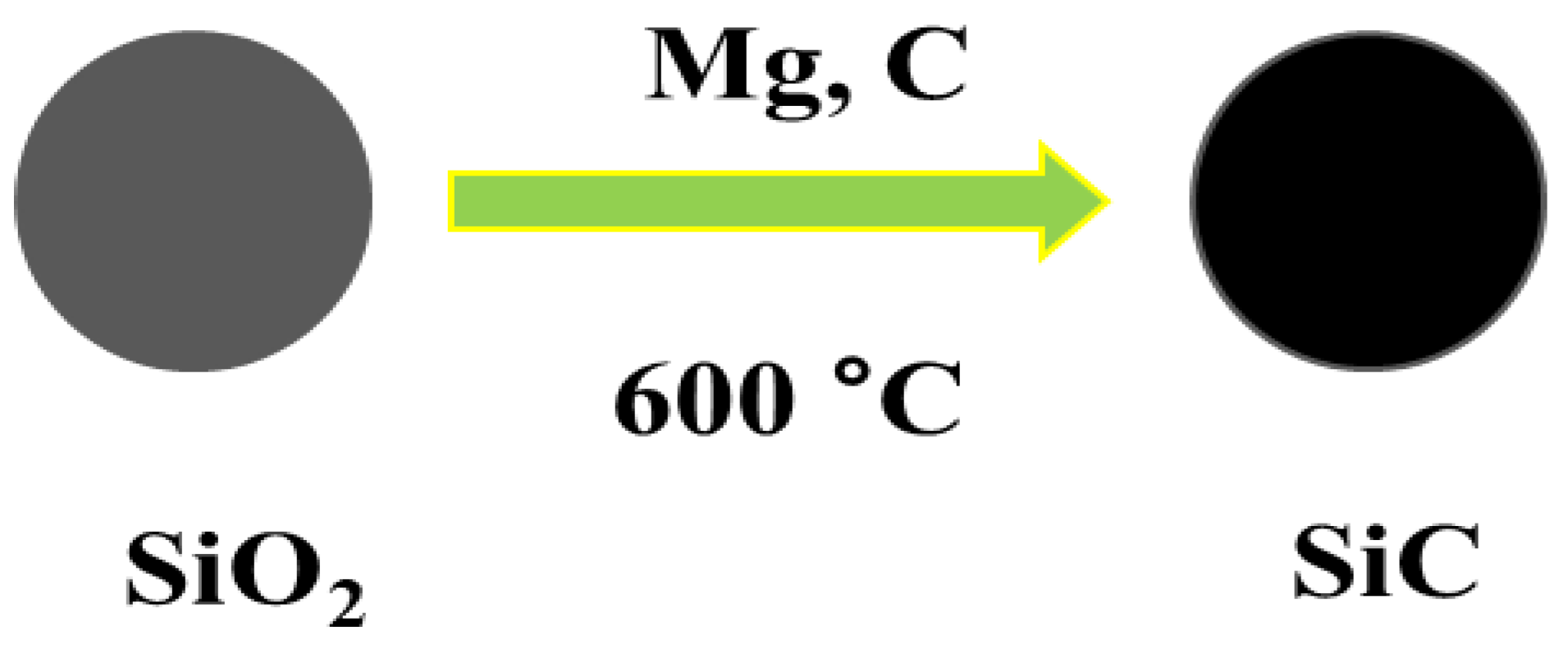


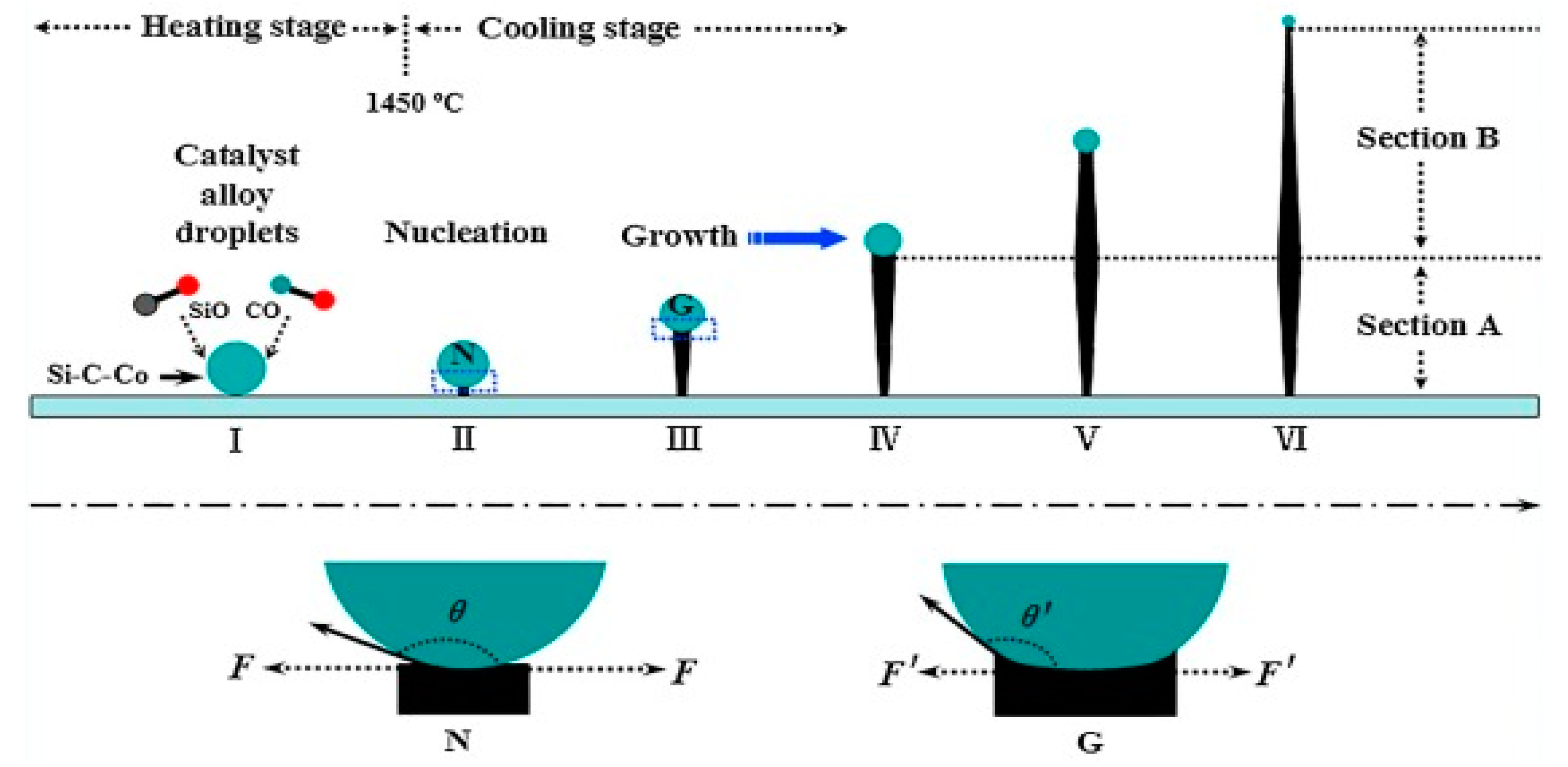

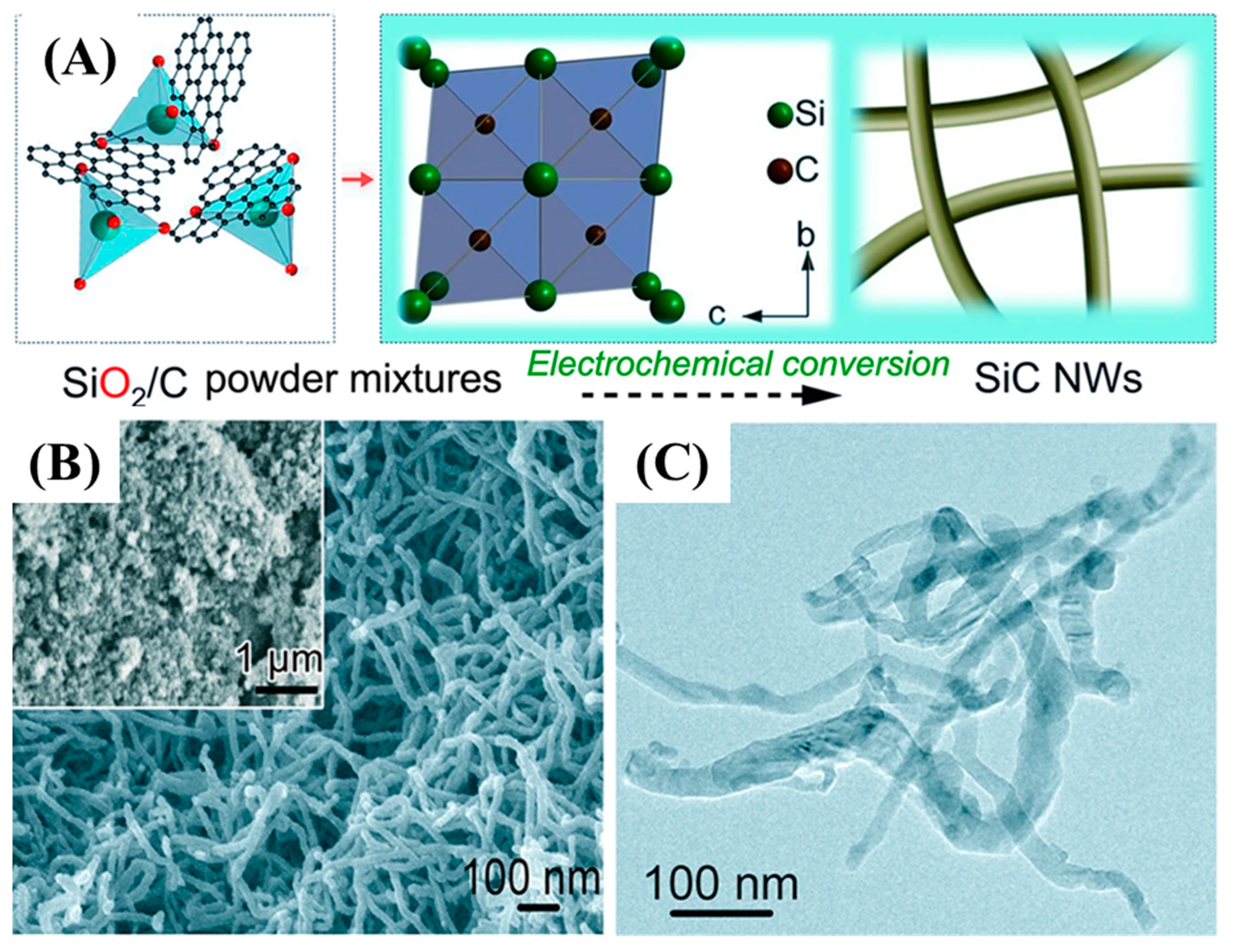
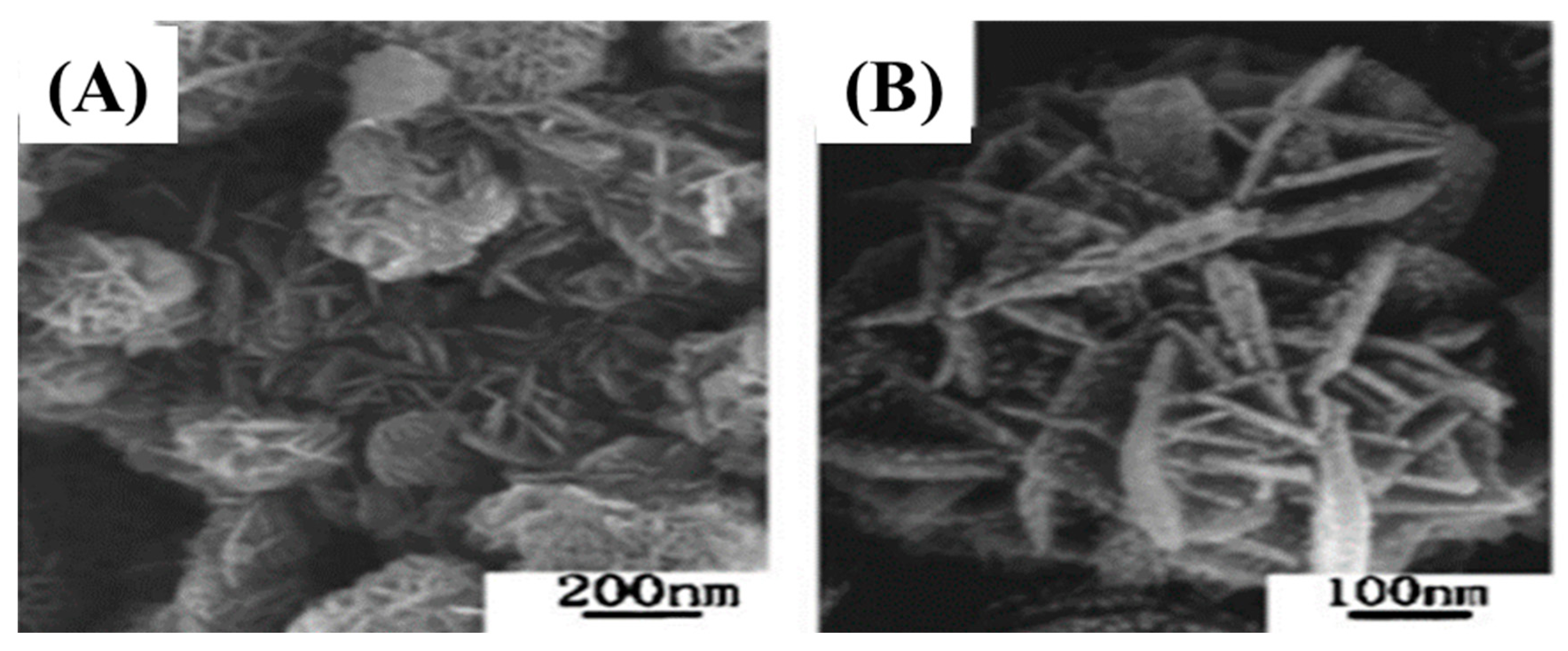

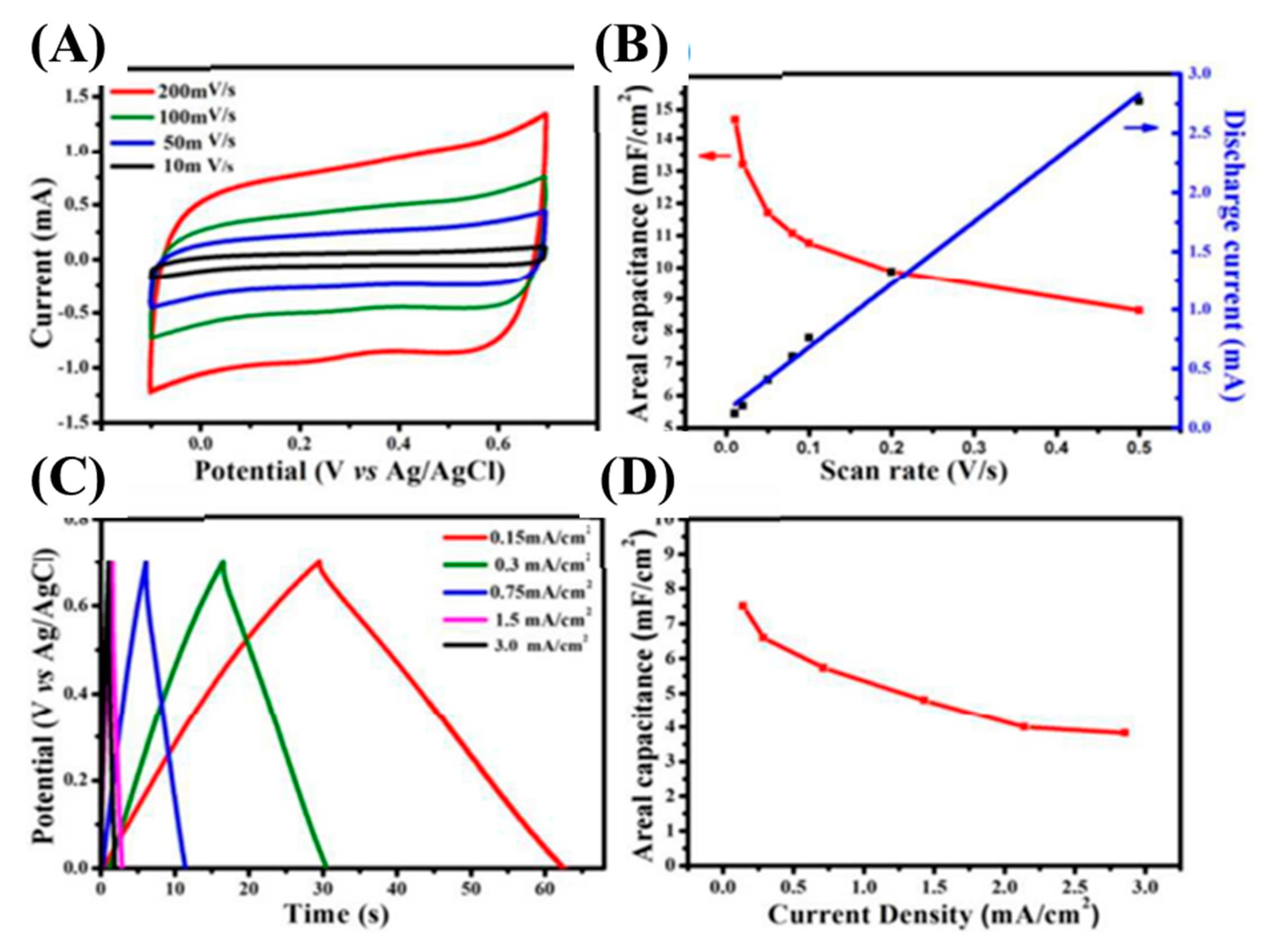
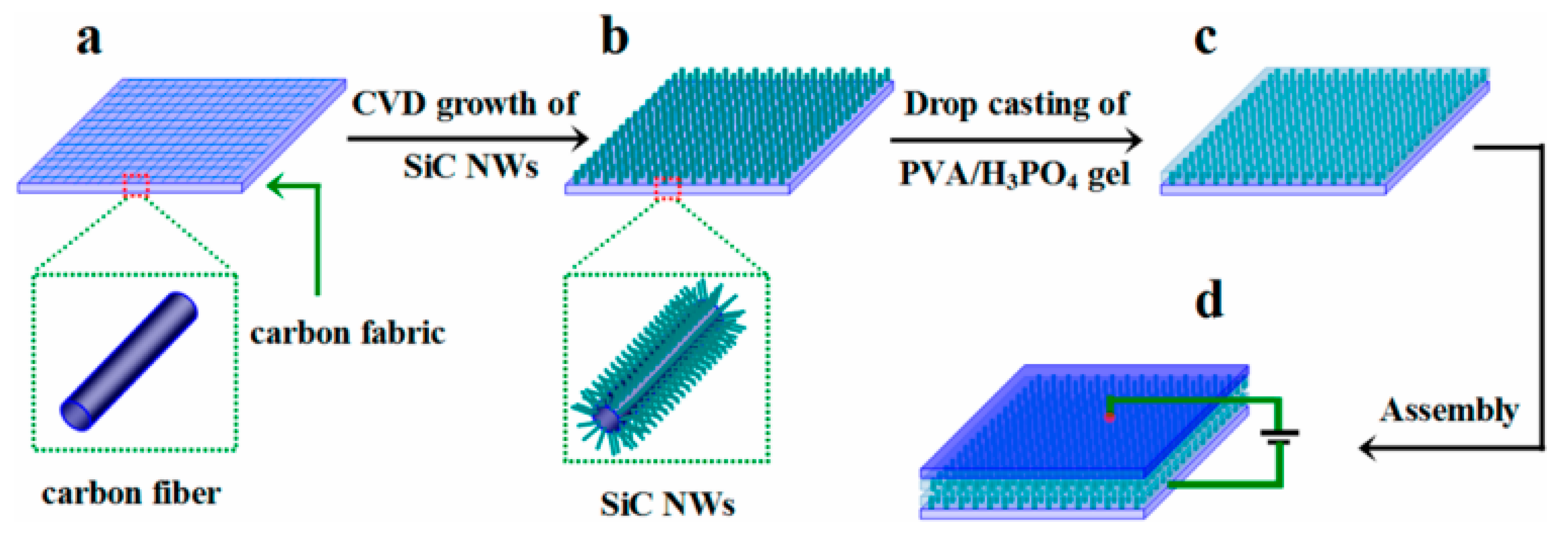



| Nanoarchitetures | Fabrication Techniques | Temperature (°C) | Ref. |
|---|---|---|---|
| β-SiC NWs | Heating | 1300 | [66] |
| β-SiC NWs | CVD | 1250 | [67] |
| β-SiC NWs | Carbothermal reduction | 1500 | [68] |
| β-SiC NWs | Electrospinning followed by carbothermal reduction | 1560 | [69] |
| Twined β-SiC NWs | CVD | 370 | [70] |
| Hexagonal β-SiC nanoprisms | Thermal evaporation | 1450 | [71] |
| β-SiC nanocones | CVD | 1300 | [72] |
| SiC nanorods | CNTs confined heating | 1200 | [73] |
| α-SiC nanorods | Arc-plasma | 2700 | [74] |
| 6H-SiC | Carbothermal reduction | 1300–1400 | [75] |
| β-SiC NWS | Thermal evaporation | 1550 | [76] |
| Inverted β-SiC NWs | Heating | 1800 | [77] |
| SiC NWs | heating | 1460 | [55] |
| β-SiC NWs | Carbothermal reduction | 1300 | [78] |
| 3C-SiC NWs | CVD | 1000 | [79] |
| N-doped 3C-SiC nanobelts | CVD | 1500 | [80] |
| Mechanical Properties | SI/Metric (Imperial) | SI/Metric | Imperial |
|---|---|---|---|
| Density | Gm/cc | 3.1 | 193.5 |
| Porosity | % | 0 | 0 |
| Color | Black | ||
| Flexural Strength | MPa | 550 | 80 |
| Elastic Modulus | GPa | 410 | 59.5 |
| Compressive Strength | MPa | 3900 | 566 |
| Shear Modulus | GPa | ||
| Bulk Modulus | GPa | ||
| Poisson’s Ratio | 0.14 | ||
| Hardness | Kg/mm2 | 2800 | |
| Fracture Toughness | MPa·m1/2 | 4.6 | - |
| Maximum Use Temperature | °C (°F) | 1650 | 3800 |
| Electric Properties | |||
| Dielectric Strength | Volt/mil | Semiconductor | |
| Volume Resistivity | Ohm·cm | Dopant dependent | |
| Thermal Properties | |||
| Thermal Conductivity | W/m·°K | 120 | |
| Coffecient of Thermal Expression | 10−6/°C | 4 | |
| Specific Heat | J/Kg·°K | 750 |
| Electrode Materials | Electrolyte | Specific Capacitance | References |
|---|---|---|---|
| 4H-SiC NWs arrays | 2 M KCl | 22.3 mF/cm2 at 10 mV/s | [119] |
| Boron doped SiC | 1 M H2SO4 | 232 F/g at 2.2 A/g | [120] |
| 4H-SiC NWs arrays | 2 M KCl | 14.8 F/cm3 at 10 mV/s | [119] |
| SiC@PANI core/shell | 1 M Na2SO4 | 352 mF/cm2 at 1 mA/cm2 | [121] |
| SiC NWs@CNTs@NiCO2O4 | 1 M KOH | 2302 F/g at 1 A/g | [122] |
| NiSi/SiC core-shell NWs | 1 M KOH | 234.13 mF/cm2 at 1 mA/cm2 | [123] |
| HPC/SiC | 1 M Na2SO4 | 234.2 F/g at 1 A/g | [124] |
| SiC NWs@MoS2 | 1 M Na2SO4 | 200.35 F/g at 0.1 A/g | [125] |
| SiC/B-MnOx | 1 M Na2SO4 | 251.3 F/g at 10 mV/s | [126] |
| SiC NWs | 3.5 M KCl | 1.7 μF/cm2 at 50 mV/s | [127] |
| SiC NWs@C | 3.3 mF/cm2 at 20 mV/s | [114] | |
| SiC NWs@PEDOT | 0.1 M TBA BF4 | 50 F/g at 100 mV/s | [128] |
| Ru@SiC NWs | 1 M Na2SO4 | 36.25 mF/cm2 at 5 mV/s | [129] |
| SiC@CF | 2 M KCl | 23 mF/cm2 at 50 mV/s | [130] |
| C@SiC | 6 M KOH | 220 F/g at 1 A/g | [131] |
| SiC NWs@Ni(OH)2 | 1 M KOH | 1724 F/g at 2 A/g | [132] |
| SiC NWs@GP | 0.1 M H2SO4 | 25.6 mF/cm2 at 0.2 A/cm2 | [133] |
| Eesoporous SiC-CDC | 0.5 M NEtBF4/AC | 80 F/g at 1 V/s | [134] |
| MnO2@SiC | 1 M Na2SO4 | 273.2 F/g at 10 mV/s | [135] |
| SiC@Fe3O4 | 1 M KOH | 423.2 F/g | [136] |
Disclaimer/Publisher’s Note: The statements, opinions and data contained in all publications are solely those of the individual author(s) and contributor(s) and not of MDPI and/or the editor(s). MDPI and/or the editor(s) disclaim responsibility for any injury to people or property resulting from any ideas, methods, instructions or products referred to in the content. |
© 2022 by the authors. Licensee MDPI, Basel, Switzerland. This article is an open access article distributed under the terms and conditions of the Creative Commons Attribution (CC BY) license (https://creativecommons.org/licenses/by/4.0/).
Share and Cite
Ojha, G.P.; Kang, G.W.; Kuk, Y.-S.; Hwang, Y.E.; Kwon, O.H.; Pant, B.; Acharya, J.; Park, Y.W.; Park, M. Silicon Carbide Nanostructures as Potential Carbide Material for Electrochemical Supercapacitors: A Review. Nanomaterials 2023, 13, 150. https://doi.org/10.3390/nano13010150
Ojha GP, Kang GW, Kuk Y-S, Hwang YE, Kwon OH, Pant B, Acharya J, Park YW, Park M. Silicon Carbide Nanostructures as Potential Carbide Material for Electrochemical Supercapacitors: A Review. Nanomaterials. 2023; 13(1):150. https://doi.org/10.3390/nano13010150
Chicago/Turabian StyleOjha, Gunendra Prasad, Gun Woong Kang, Yun-Su Kuk, Ye Eun Hwang, Oh Hoon Kwon, Bishweshwar Pant, Jiwan Acharya, Yong Wan Park, and Mira Park. 2023. "Silicon Carbide Nanostructures as Potential Carbide Material for Electrochemical Supercapacitors: A Review" Nanomaterials 13, no. 1: 150. https://doi.org/10.3390/nano13010150
APA StyleOjha, G. P., Kang, G. W., Kuk, Y.-S., Hwang, Y. E., Kwon, O. H., Pant, B., Acharya, J., Park, Y. W., & Park, M. (2023). Silicon Carbide Nanostructures as Potential Carbide Material for Electrochemical Supercapacitors: A Review. Nanomaterials, 13(1), 150. https://doi.org/10.3390/nano13010150









